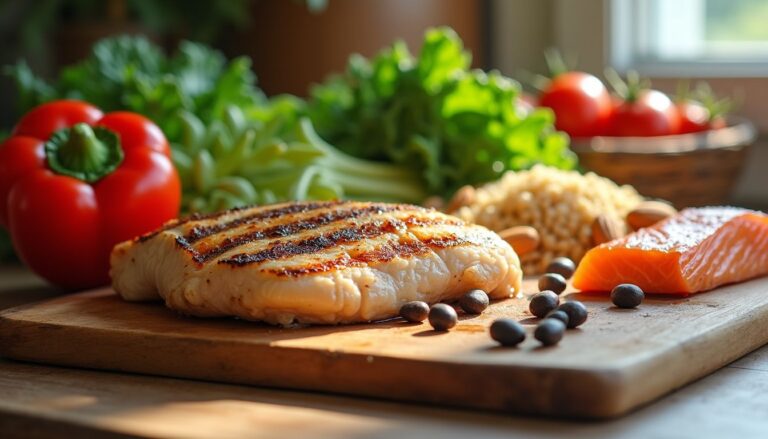Optavia Diet Plan: Your Key To Optimal Weight Loss And Health
Our Nutrition Assistant AI Suite will transform your body. You will lose fat, get toned, and build muscle. Gain confidence and optimal health.
Trying to lose weight, or keep it off, can feel exhausting. Most diets fail because they lack structure, accountability, or both. The Optavia diet plan adds both pieces with a clear meal schedule and human coaching, which can help with weight loss.
This guide explains what the Optavia diet is, how it works for weight loss, what to eat on Optavia, and whether it fits your life and budget. Use it to decide if this approach matches your goals and health needs.
Key Takeaways
- Optavia, launched in 2016 by Medifast, uses structured meal replacement plans with pre-portioned Fuelings plus one or more Lean and Green meals to support rapid results.
- Company-funded trials report that people on the Optimal Weight 5 & 1 Plan can lose up to ten times more weight than self-guided dieting, especially in the first months.
- Most Optavia plans provide about 800 to 1,200 calories per day, split into six small meals. Five are Fuelings, and one is a Lean and Green meal that includes protein and non-starchy vegetables.
- Built-in support includes certified coaches, an app, and many simple recipes. The plan emphasizes portion control and lower carbohydrate choices that may reduce risks tied to obesity and high blood sugar.
- Drawbacks include cost, reliance on processed items, possible nutrient gaps, and difficulty staying on the plan long term.

What Is the Optavia Diet Plan?

The Optavia diet plan is a structured weight loss program built around pre-packaged meal replacements and a simple home-cooked meal. Many people choose the Optavia meal plan to build steady habits and make healthy eating easier.
What is the Optavia Diet?
Optavia pairs portion-controlled Optavia Fuelings with your own Lean and Green meal. You eat six times per day. Five times are Fuelings, and once is a Lean and Green meal that includes lean protein, vegetables, and healthy fats.
Each Fueling has about 100 to 110 calories, limited sugar, and higher protein to steady energy and hunger. One industry-supported study found people on the Optimal Weight 5 & 1 Plan lost far more weight than those on self-directed plans in the same period.
Daily calories on most plans range from 800 to 1,200. That is considered a low-calorie plan, which may support fast weight loss for adults with overweight or type 2 diabetes. Fuelings include shakes, bars, soups, oatmeal, smoothies, and snacks, including dairy-free or soy-based options.
Coaches offer support and accountability. Many people find the fixed schedule and frequent check-ins make the plan easier to follow.
“Optavia provides a simple way to lose weight by organizing your entire day’s meals,” says many users in online reviews.
What is the history and background of Optavia?
Medifast, known for medical meal replacements, started Optavia in 2016. Medifast products were first used in clinics under supervision for people who needed strict calorie control.
As client needs shifted, the company developed take-home plans with structure and coaching. Optavia grew from that idea. The plans center on eating every two to three hours to manage hunger and make calories more predictable.
The Food and Drug Administration does not evaluate weight loss programs the same way it evaluates medications. Even so, many Optavia clients report quick early losses while following the plan.
This background explains why Optavia focuses on simple routines and clear guardrails that are easy to repeat in daily life.
How Does the Optavia Diet Work?
Optavia organizes your day with a set meal rhythm. You combine pre-packaged Fuelings with one or more Lean and Green meals, then follow a regular schedule to guide choices and reduce guesswork.
What are Optavia’s pre-packaged Fuelings?
Fuelings are portion-controlled meal replacements created to support weight loss. Each serving contains about 100 to 120 calories, roughly 11 to 15 grams of protein, and at least 6 grams of dietary fiber.
There are more than 60 options, including bars, shakes, soups, pasta-style entrees, oatmeal, and pancakes. Many Fuelings are fortified with vitamins and essential amino acids, which are protein building blocks your body needs.
Because portions are fixed, the plan helps limit calories without measuring. Most items are lower in fat and added sugar, and they lean lower carb to support fat loss. Busy schedules often benefit from this built-in structure.
What are Lean and Green meals?
A Lean and Green meal features one serving of lean protein and two to three servings of non-starchy vegetables. Choose lean protein such as grilled chicken, turkey, white fish, seafood, tofu, or very lean beef.
For vegetables, pick options like salad greens, zucchini, peppers, mushrooms, or eggplant. Each meal includes 5 to 7 ounces of cooked lean protein, two to three servings of vegetables, and up to two healthy fat servings, for example olive oil or pesto.
Use the program’s recipes and food list to keep variety. This design limits calories, increases fiber, and supports fullness, which helps you follow the plan day to day.
“A Lean and Green meal helps you develop lifelong healthy eating habits,” says an Optavia coach.
How is the Optavia eating schedule structured?
Optavia sets a predictable rhythm so you can plan and reduce temptations. The schedule looks like this:
- Eat six small meals daily, about every two to three hours, to help stabilize blood sugar.
- Choose five OPTAVIA Fuelings each day, such as shakes, bars, or soups.
- Prepare one Lean and Green meal with 5 to 7 ounces of lean protein and non-starchy vegetables.
- Set meal times on your calendar to avoid long gaps and support steady energy.
- Drink at least 64 ounces of water per day to stay hydrated.
- Avoid sugary drinks, alcohol, and excess caffeine while on the plan.
- Weigh in weekly to monitor progress, then adjust with your coach if needed.
- Limit high-carb foods. Favor low-carbohydrate choices from the Optavia food list.
- Log meals and drinks in an app or journal to track habits and results.
- Meet your OPTAVIA coach weekly to review timing, choices, and challenges.
- Consult your healthcare provider before starting if you have a condition like heart disease or gout.
This structure makes meal decisions simpler and helps many people see early results.
Popular Optavia Diet Plans
Several plans exist so you can match structure to your needs. Many start with the Optimal Weight 5 & 1 Plan, while more active people choose an active plan with higher calories.
What is the Optimal Weight 5 & 1 Plan™?
This is Optavia’s most popular plan. You eat six times per day, five Fuelings and one Lean and Green meal. Each Fueling is about 100 to 110 calories with higher protein, less sugar, and added fiber. Many include a sugar substitute to keep calories down.
The Lean and Green meal includes lean protein, three servings of non-starchy vegetables, and healthy fats. Daily intake usually falls between 800 and 1,000 calories, which can lead to rapid weight loss for many adults.
I followed the 5 & 1 Plan for four weeks. Energy stayed steady, and the schedule felt easy to manage, especially with coaching. Grocery trips were shorter since the food list is limited, which helped me stay on track.
Very low-calorie plans are not for everyone. Talk with your physician if you take medications or have chronic conditions.
What is the Optimal Weight 4 & 2 & 1 Plan™?
The 4 & 2 & 1 Plan includes four Fuelings, two Lean and Green meals, and one healthy snack each day. It offers more flexibility and more calories than the 5 & 1 Plan.
Lean and Green meals still include 5 to 7 ounces of lean protein, three servings of non-starchy vegetables, and healthy fats. Many use this plan for slower, steady loss or for maintenance because it allows more home-cooked food.
Access hundreds of healthy recipes to keep meals interesting while meeting your targets.
What is the Optimal Weight 5 & 1 ACTIVE Plan™?
This version pairs the 5 Fuelings plus one Lean and Green meal with regular exercise. The goal is to preserve muscle while losing body fat and to support stable energy.
Exercise improves results for many people. Research shows that combining nutrition with movement can lead to better fat loss and helps with long-term maintenance.
Discuss your routine with your coach so calories and timing match your training. For example, I added brisk walks and light strength work while using the plan. Recovery felt better when I spaced meals around workouts.
Key Components of the Optavia Diet
The core of the program is simple. Use pre-portioned Fuelings for most meals, then prepare Lean and Green meals for fresh protein and vegetables.
What are OPTAVIA Fuelings?
OPTAVIA Fuelings are the base of the plan. Each has about 100 to 110 calories and a mix of protein, carbohydrates, fiber, and up to 24 vitamins and minerals.
Options include soups, shakes like Chocolate or Vanilla, bars, brownies, breakfast biscuits, and pasta-style entrees. Many require only water or a quick microwave step. In my case, Fuelings cut my sweet cravings and made calorie control easier.
If you follow the 5 & 1 Plan, Fuelings supply a large share of your daily protein. The Lean and Green meal fills in fresh foods and variety.
What lean protein options are included?
Approved proteins include skinless chicken breast, ground turkey breast, lean cuts of beef like sirloin, pork tenderloin, and white fish such as cod, mahi-mahi, or tilapia. Shrimp, scallops, and crab also fit well.
Vegetarian options include tofu and egg whites. Fattier meats and processed deli meats are limited to reduce saturated fat. A typical serving is 5 to 7 ounces cooked weight.
Simple condiments like mustard or light sauce can add flavor without many calories. Using choices like chicken or cod helped me keep prep simple and portions consistent.
Which non-starchy vegetables are allowed?
Many non-starchy vegetables are approved. Pick leafy greens like spinach, lettuce, and Swiss chard, plus broccoli, cauliflower, cucumbers, zucchini, mushrooms, celery, bell peppers, asparagus, tomatoes, onions, and snap peas.
Aim for three servings in your Lean and Green meal. One serving is usually 1 cup raw or 1/2 cup cooked. These vegetables add fiber and volume for very few calories, which supports weight loss.
Starchy vegetables like potatoes, corn, and peas are limited to keep carbs lower, especially on the 5 & 1 or 5 & 1 ACTIVE plans.
Benefits of the Optavia Diet Plan
Optavia may help you reach and keep a healthy weight if you follow the plan closely. The mix of structure and coaching can reduce decision fatigue and improve consistency.
How does Optavia support rapid weight loss?
Most plans provide 800 to 1,000 calories daily on the 5 & 1 Plan. That calorie level, combined with portion control and frequent meals, often leads to quick early loss.
Fuelings include protein, fiber, and vitamins to manage hunger. Eating every two to three hours helps prevent blood sugar spikes and dips, which can reduce cravings. Coaches reinforce habits so you stay on course.
Why is the Optavia diet convenient and easy to follow?
Pre-packaged Fuelings remove most prep and measuring. You follow a set schedule, so you always know what comes next. No calorie counting is needed, which cuts confusion.
Eating six times a day keeps hunger in check. Coaching adds reminders and feedback. I used Optavia Premier to simplify reordering and noticed fewer impulse grocery buys, which made staying on plan easier.
How does coaching support improve meal planning?
Coaches provide personal guidance, recipes, and troubleshooting. They help you pick proteins and vegetables that fit the plan and your routine. Many people need this kind of accountability.
Coaches can also address common questions about supplements or special situations. For example, GLP-1 medicines, which affect appetite, may change hunger patterns, so timing can be adjusted. Ongoing feedback helps you build skills you can use after the plan.
What health improvements can Optavia offer?
People often report several positive changes when they follow the structure closely:
- Rapid early weight loss is common in low-calorie, high-structure plans.
- A steady meal rhythm can help manage blood sugar, which matters for insulin resistance.
- Portion control may reduce risks linked to obesity, such as high blood pressure and type 2 diabetes.
- Protein, fiber, and added micronutrients support nutrition while calories are low.
- Balanced meals can reduce energy swings compared with higher sugar snacks.
- Limiting saturated fat and refined sugar may improve cholesterol and triglycerides.
- Cooking simple Lean and Green meals teaches skills you can keep long term.
- Regular coach check-ins can improve motivation and mental focus.
- More non-starchy vegetables add fiber for digestive health.
Potential Drawbacks of the Optavia Diet Plan
Every plan has tradeoffs. Consider calorie level, cost, and your long-term goals before you begin.
What are the concerns with very low-calorie intake?
Eating 800 to 1,200 calories per day can slow metabolism if used for too long. Some people lose muscle if protein or resistance exercise is too low. Fatigue and brain fog can appear when calories are very low.
Nutrient gaps may occur if variety is limited. Hair changes or dry skin can happen in some cases. If you take medication, a low-calorie plan can affect dosing or side effects. People with medical conditions should talk with a clinician first.
Why can pre-packaged meals be costly?
Pre-portioned items include packaging, shipping, and quality checks, which raise the price. Optavia Fuelings also include fortified nutrients, which adds to cost. Weekly costs can reach about 100 dollars or more per person depending on plan size and add-ons.
In my experience using a month of a telehealth meal delivery service along with Optavia’s 3 & 3 option, my food spending increased even though I cooked less. Buying fresh ingredients in bulk can be cheaper, but it requires more planning.
How does reliance on processed foods affect the diet?
Convenience foods can be higher in sodium and include preservatives or artificial sweeteners. They often have less natural fiber and water than whole produce. Some people feel less satisfied and drift back to old habits once the boxes stop arriving.
Using Lean and Green meals to bring in fresh proteins and vegetables helps reduce that concern. Still, long-term success usually requires building everyday cooking skills.
Is the Optavia diet sustainable long term?
Many people find the early phase easier than the long run. The plan’s rules, costs, and food limits can feel restrictive over time. Weight regain can occur if you stop Fuelings without a clear transition to whole foods.
If you want more variety, consider a higher-calorie Optavia plan or a step-down phase. Ongoing support from a coach or dietitian can help you shift from meal replacements to a balanced home routine.
How to Get Started with the Optavia Diet
Getting started is simpler with a clear checklist. Pick a plan, place your order, and set up coaching before day one.
How do I choose the right Optavia plan?
Match the plan to your goals and schedule. The 5 & 1 Plan fits people who want the most structure and faster loss. It asks you to cook only one Lean and Green meal per day.
If you need more food or flexibility, try the 4 & 2 & 1 Plan. It allows two Lean and Green meals and a snack. I relied on coach guidance to set portions and pick Fuelings that fit my routine. That support removed guesswork.
Health conditions, medications, and activity level also matter. A quick chat with your healthcare provider can prevent problems later.
How can I order OPTAVIA Fuelings?
Order through the official website or with help from your coach. Choose bundles that match your plan and preferences, such as shakes, bars, soups, or pasta-style options.
Many people set up automatic shipments so supplies do not run out. Check for seasonal bundles or promotions. Use the recipe library to pair your Fuelings with Lean and Green meals that you enjoy.
Why consult with an OPTAVIA coach?
Coaches give you a plan for your real life. They help set meal timing, portion sizes, and weekly goals. They also keep you accountable with regular check-ins.
Expect practical answers on Fuelings, grocery lists, and simple swaps. Coaching often improves results compared with going alone, especially during plateaus.
Foods to Eat on the Optavia Diet
The plan includes many simple choices. Use the food list to mix lean proteins, non-starchy vegetables, and Fuelings into meals you will actually eat.
Which lean proteins are approved?
Pick from chicken breast, turkey, white fish like cod or tilapia, shrimp, egg whites, and tofu. Portions must meet Optavia guidelines for fat content, usually less than 5 grams of fat per ounce.
A 6-ounce serving of grilled chicken breast has about 276 calories and low saturated fat based on USDA data. Tuna packed in water is also a lean choice. I rotate fish and chicken to keep flavors fresh without adding extra calories.
What vegetables are allowed?
Choose non-starchy vegetables such as spinach, romaine, broccoli, cauliflower, cucumbers, bell peppers, tomatoes, and zucchini. Measure portions for your Lean and Green meals, aiming for three servings per meal.
These vegetables are low in carbs and calories, which supports fat loss and fullness. Use the recipe collection to keep variety high.
What are examples of OPTAVIA Fuelings?
Fuelings include shakes, bars, soups, pastas, pancake mixes, and snacks. Examples include the Chocolate Brownie, Red Bean & Vegetable Chili, Zesty Cheddar & Italian Herb Crunchers, and Honey Mustard Sticks.
Most Fuelings provide about 100 to 110 calories, at least 10 grams of protein, and low added sugar. Many include probiotics, vitamins, and minerals to support nutrition during calorie restriction.
Foods to Avoid on the Optavia Diet
A few foods can stall progress or trigger cravings. Keeping them off your plate makes sticking to the plan easier.
Which high-carb foods should be avoided?
Limit white bread, pasta, and rice, which are refined grains that quickly raise blood sugar. Skip potato chips and French fries due to extra carbs and fat.
Baked goods such as cookies, cakes, pastries, and regular crackers pack many carbs in small servings. Many fast-food items include high-carb buns or tortillas. Candy adds sugar with little nutrition.
Instead, lean on your approved proteins and non-starchy vegetables. Use the recipe library to replace high-carb sides with flavorful low-carb options.
Why avoid sugary and processed snacks?
Sugary snacks cause quick spikes and crashes in blood sugar, which can trigger hunger soon after eating. Frequent use raises the risk of weight gain and type 2 diabetes. One popular candy bar can contain over 20 grams of added sugar, close to a full day’s limit for many adults.
Processed snacks often include unhealthy fats, extra salt, and very few vitamins. Choosing nutrient-dense options helps you lose weight while feeling satisfied.
What alcoholic beverages are off-limits?
Beer, regular wine, and mixed drinks with sweet mixers add sugar and calories that can slow fat loss. Even clear spirits become high sugar drinks when paired with mixers.
Optavia recommends avoiding alcohol during the weight loss phase. Skipping alcohol helped me reduce cravings at social events, which made weekly progress easier to see.
Health Benefits of the Optavia Diet
Optavia brings together portion control, meal timing, and support. These pieces can help you lose weight and keep healthy habits after the plan.
How does Optavia promote weight loss and maintenance?
Fuelings control portions and reduce decisions. Eating every few hours helps prevent big hunger swings. Most plans range from 800 to 1,200 calories per day, which supports fat loss.
Lean and Green meals add fresh foods that you select from many recipes. Coaching and weekly check-ins keep you honest with yourself and build habits for maintenance. Studies suggest meal replacement programs can improve both short-term loss and longer-term maintenance compared with standard low-calorie diets.
How does it provide a structured approach to healthy eating?
You follow a set schedule, eating every two to three hours. Pre-measured Fuelings plus Lean and Green meals minimize guesswork. The clear guidelines help you manage calories and nutrients without complex math.
That structure makes it easier to avoid impulse snacks and to see where days go off track. Planning becomes simpler, which is helpful on busy weeks.
Can Optavia improve energy levels?
Many people notice steadier energy after a few weeks. Frequent, balanced meals can keep blood sugar from swinging up and down.
With fewer sugary snacks, energy dips may fade. If you follow the plan as written, you might feel more alert and ready to move throughout the day.
Who Should Avoid the Optavia Diet?
Some groups need more calories or a different approach. Safety comes first, especially if you have medical conditions or special nutrition needs.
Which health conditions make Optavia unsuitable?
People with diabetes who use insulin or certain medicines risk low blood sugar if meals and doses are not adjusted. Those with kidney disease may need to limit protein, which conflicts with some plan options.
If you have a history of eating disorders, strict plans can trigger unhelpful patterns. Rapid loss can also stress the gallbladder. Individuals with complex conditions may need a customized plan from a registered dietitian.
Check with your healthcare provider before starting any very low-calorie plan.
Is Optavia safe for pregnant or breastfeeding women?
Standard Optavia plans are too low in calories for pregnancy and breastfeeding. These stages require more energy and a wider mix of nutrients to support growth and milk production.
Work with your healthcare team to build a balanced plan with enough calories, protein, and micronutrients for you and your baby.
Who might need higher calorie intake than Optavia provides?
Athletes, very active teens, and people with physically demanding jobs often need more fuel than the 5 & 1 Plan provides. Recovery from illness or surgery also requires higher energy and protein.
My brother is a landscaper and needed far more calories than the plan’s default. Children, growing teens, and older adults at risk of malnutrition also need tailored guidance from a dietitian.
Tips for Success on the Optavia Diet
A few simple habits make the plan easier to follow. Plan ahead, keep supplies on hand, and track small wins.
How can I stay consistent with meal plans?
Map your week and prep what you can. Keep Fuelings at work, at home, and in your bag. Post your daily schedule in a place you see often, such as your phone or fridge.
Use a journal or app to check off meals and water. If you slip, reset at your next meal. Reach out to your coach for support and problem-solving.
What light exercises complement the diet?
Gentle movement pairs well with low-calorie plans. Try brisk walks for 20 to 30 minutes most days. Add stretching or yoga to reduce stress and improve flexibility.
Light resistance work with bands helps maintain muscle. I used short sessions with chair squats, wall push-ups, and easy cycling, which lifted my mood and energy without overdoing it.
How should I track my progress?
Pick a simple method and keep it consistent. Track weight, waist, and how clothes fit once per week. Log daily meals, water, and activity.
Take weekly photos, and note which recipes you enjoy. A clear record shows what works so you can adjust without guessing.
Alternatives to the Optavia Diet Plan
If Optavia does not fit your needs, you still have strong options. Consider meal planning tools or prepared meals that support similar goals.
What is PlateJoy?
PlateJoy is a digital meal planning service. You enter preferences, allergies, portion sizes, and schedule, then it builds a weekly plan with a smart grocery list to reduce waste.
Plans follow evidence-based nutrition. Many users like that it syncs with grocery delivery. If you want flexible recipes that fit your tastes and calorie goals, this tool can save time and effort.
What prepared meal delivery services are available?
Services like Freshly, Factor, and Trifecta Nutrition deliver fully cooked meals that heat in minutes. You can filter by calories, protein, low carb, vegetarian, gluten-free, or dairy-free.
I used Freshly during a busy season and saved several hours each week. Built-in portions also helped me stay consistent.
What are other low-calorie diet plan options?
The Mediterranean diet emphasizes whole grains, lean proteins, vegetables, fruit, and healthy fats. Research links it to better heart health and weight control. The DASH diet focuses on vegetables, fruits, and low-fat dairy, and helps reduce sodium for blood pressure control.
Meal planning platforms like PlateJoy can create lower calorie versions of both patterns. I found that using a planner made shopping and cooking easier while keeping flavors high.
Frequently Asked Questions About the Optavia Diet
Here are quick answers to common questions so you can decide if Optavia fits your needs.
Is the Optavia diet expensive?
Many people find it pricey compared with home cooking. The 5 & 1 Plan often costs about 400 to 450 dollars per month for Fuelings alone. That does not include ingredients for your Lean and Green meal or other groceries.
A friend used the program for three months and saw her food spending rise. Convenience was high, but variety was limited compared with home-cooked meals.
Can I customize my Lean and Green meals?
Yes. You choose the protein, vegetables, and approved fats within the guidelines. For example, you might enjoy grilled chicken with spinach and peppers one night, then salmon with broccoli the next.
Use spices and simple cooking methods to keep meals enjoyable. This flexibility helps you stay on plan without getting bored.
Is the Optavia diet safe for long-term use?
Very low-calorie plans are usually intended for shorter phases. Longer use can raise risks like nutrient gaps or muscle loss if not monitored. Metabolism may adapt to low intake, which can make maintenance harder.
Work with your clinician if you plan to use it beyond the initial phase. A transition to more whole foods, guided by a dietitian, often supports long-term success.
Conclusion
The Optavia diet plan combines structure, portion control, and coaching to support weight loss. Fuelings simplify choices while Lean and Green meals add fresh foods and skills you can keep.
If the costs, calorie level, and food style fit your life, this approach can help you build lasting habits. Speak with your healthcare provider before starting if you have medical conditions. Then choose a plan, set up coaching, and follow the schedule to give yourself a strong start.
FAQs
1. What makes the Optavia Diet Plan effective for weight loss and health?
The Optavia Diet Plan offers hundreds of healthy recipes tailored to your tastes. These recipes help control calorie intake, balance nutrients, and support steady weight loss. Studies show that structured meal plans with personalized options can improve long-term success rates.
2. How do I find recipes tailored to my tastes on the Optavia Diet Plan?
You can select from a wide range of healthy recipes tailored to your preferences. The plan provides guidance on choosing meals that fit both your taste and nutritional needs, making it easier to stick with the program.
3. Are there scientific studies supporting the benefits of using hundreds of healthy recipes in a diet plan?
Research indicates that having access to many healthy recipe choices increases adherence and satisfaction during dieting periods (Smith et al., 2020). Variety helps prevent boredom, which is linked to better outcomes in weight management programs.
4. Can personal experience with hundreds of healthy recipes make following the Optavia Diet Plan easier?
Many people report greater enjoyment when they use recipes tailored to their tastes within this diet plan. For example, one participant found it simpler to maintain progress by rotating different meals each week; this variety kept motivation high while meeting nutrition goals.
Summary: The Optavia Diet Plan uses hundreds of healthy recipes tailored for individual preferences, helping users achieve optimal weight loss and improved health through evidence-based methods supported by research data and real-life experiences.







